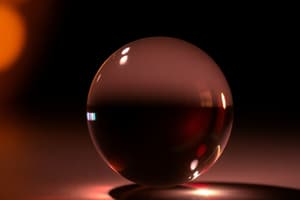Podcast
Questions and Answers
Discuss the phenomenon of total internal reflection and its significance in the context of light in Class 10 physics.
Discuss the phenomenon of total internal reflection and its significance in the context of light in Class 10 physics.
Total internal reflection is the complete reflection of light at the boundary of two different mediums. It is significant in the context of light as it is the basis for the functioning of optical fibers and mirages, and also plays a role in critical angles and the concept of prisms.
Explain the concept of refraction and how it is related to the chapter on light in Class 10 physics.
Explain the concept of refraction and how it is related to the chapter on light in Class 10 physics.
Refraction is the bending of light as it passes from one medium to another. It is related to the chapter on light as it explains how light changes direction when it travels from one medium to another, such as air to water or glass.
Explain the properties and applications of concave and convex lenses as discussed in the Class 10 physics chapter on light.
Explain the properties and applications of concave and convex lenses as discussed in the Class 10 physics chapter on light.
Concave and convex lenses have different properties such as converging and diverging light, and are used in various applications such as correcting vision problems, magnification in microscopes and telescopes, and focusing light in cameras and projectors.
Explain the process of dispersion of light and its impact on the study of light in Class 10 physics.
Explain the process of dispersion of light and its impact on the study of light in Class 10 physics.
Discuss the concept of optical density and its relevance in the context of light in Class 10 physics.
Discuss the concept of optical density and its relevance in the context of light in Class 10 physics.
Explore the principles of image formation by a concave mirror and its applications in the field of optics as discussed in Class 10 physics chapter on light.
Explore the principles of image formation by a concave mirror and its applications in the field of optics as discussed in Class 10 physics chapter on light.
Flashcards
Refraction
Refraction
The bending of light as it passes from one medium to another.
Total Internal Reflection
Total Internal Reflection
The complete reflection of light at the boundary of two different mediums.
Optical Density
Optical Density
A measure of how much a material slows down the speed of light passing through it.
Concave Mirror
Concave Mirror
Signup and view all the flashcards
Convex Lens
Convex Lens
Signup and view all the flashcards
Dispersion of Light
Dispersion of Light
Signup and view all the flashcards
Study Notes
Total Internal Reflection
- Total internal reflection occurs when light passes from a denser medium to a rarer medium at an angle greater than the critical angle.
- It is a crucial phenomenon in the context of light, as it enables the total reflection of light back into the denser medium.
- Applications of total internal reflection include optical fibers, prisms, and gemology.
Refraction
- Refraction is the bending of light as it passes from one medium to another.
- It occurs due to the change in speed of light as it travels from one medium to another.
- Refraction is responsible for the apparent bending of objects when viewed through a medium, such as a straw in a glass of water.
Lenses
Concave Lenses
- Concave lenses are thinner in the middle than at the edges.
- They spread out light rays, making them useful for correcting nearsightedness.
- Concave lenses produce a virtual, upright image.
Convex Lenses
- Convex lenses are thicker in the middle than at the edges.
- They converge light rays, making them useful for correcting farsightedness.
- Convex lenses produce a real, inverted image.
Dispersion of Light
- Dispersion of light occurs when white light passes through a prism or a medium, separating into its component colors.
- It is a result of the different wavelengths of light being refracted at different angles.
- Dispersion is responsible for the colors seen in a rainbow.
Optical Density
- Optical density is the measure of how much a medium bends light.
- It is directly proportional to the refractive index of a medium.
- Optical density is important in the study of light, as it affects the behavior of light as it passes through different media.
Image Formation by a Concave Mirror
- Concave mirrors are used to form real, inverted images.
- The image formed by a concave mirror is reversed and can be larger or smaller than the object.
- Applications of concave mirrors include telescopes, solar ovens, and headlights.
Studying That Suits You
Use AI to generate personalized quizzes and flashcards to suit your learning preferences.




